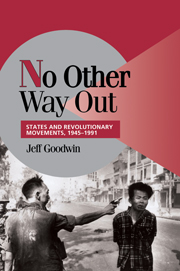Book contents
- Frontmatter
- Contents
- Figures, Tables, and Maps
- Abbreviations and Acronyms
- Preface and Acknowledgments
- Part 1 Introduction
- Part 2 Southeast Asia
- Part 3 Central America
- CHRONOLOGY FOR CENTRAL AMERICA
- 5 THE FORMATION OF REVOLUTIONARY MOVEMENTS IN CENTRAL AMERICA
- 6 NOT-SO-INEVITABLE REVOLUTIONS: THE POLITICAL TRAJECTORY OF REVOLUTIONARY MOVEMENTS IN CENTRAL AMERICA
- Part 4 Further Comparisons and Theoretical Elaborations
- Annotated Bibliography
- Index
- Titles in the series
6 - NOT-SO-INEVITABLE REVOLUTIONS: THE POLITICAL TRAJECTORY OF REVOLUTIONARY MOVEMENTS IN CENTRAL AMERICA
Published online by Cambridge University Press: 05 June 2012
- Frontmatter
- Contents
- Figures, Tables, and Maps
- Abbreviations and Acronyms
- Preface and Acknowledgments
- Part 1 Introduction
- Part 2 Southeast Asia
- Part 3 Central America
- CHRONOLOGY FOR CENTRAL AMERICA
- 5 THE FORMATION OF REVOLUTIONARY MOVEMENTS IN CENTRAL AMERICA
- 6 NOT-SO-INEVITABLE REVOLUTIONS: THE POLITICAL TRAJECTORY OF REVOLUTIONARY MOVEMENTS IN CENTRAL AMERICA
- Part 4 Further Comparisons and Theoretical Elaborations
- Annotated Bibliography
- Index
- Titles in the series
Summary
The Somocista circle consisted of a vast conglomerate of various enterprises. The mechanisms of the enrichment process resemble – though only formally – those procedures that the grand vizier placed at the disposition of his close circle of favorites in order to assure their prosperity. Because those procedures were accompanied by a high level of physical violence and arbitrariness – while always being perceived as personal concessions from the caliph – they produced a structure of loyalties with striking similarities to the patrimonial game of feudal domination.
– Edelberto Torres Rivas (1989: 128)El Salvador was different. … [T]he regime did not provide the population with a single figure like Somoza, whom everyone loves to hate. The problem in El Salvador was an economic and political system, a far more amorphous enemy.
– Tommie Sue Montgomery (1995: 115)The impressive growth, especially in the late 1970s, of popular revolutionary movements in Nicaragua, El Salvador, and Guatemala was predicated upon the violent closure of the infra structurally weak authoritarian regimes in those countries. Yet these regimes did not prove equally vulnerable to the movements that they unwittingly helped to construct. Only the movement in Nicaragua, which harnessed a vast popular insurrection that it only loosely controlled, actually seized state power, toppling the Somoza dictatorship and the National Guard in July 1979. The Sandinista revolution, moreover, occurred quite rapidly – less than two years after the Sandinistas reemerged publicly following a period of “accumulating forces in silence.”
- Type
- Chapter
- Information
- No Other Way OutStates and Revolutionary Movements, 1945–1991, pp. 180 - 214Publisher: Cambridge University PressPrint publication year: 2001



